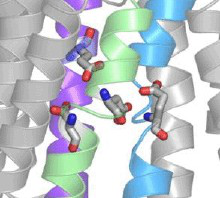The role of amino acids
 2018-11-02 13:14:00
2018-11-02 13:14:00
As a protein of the first nutrient element in the body, its role in food nutrition is obvious, but it cannot be directly utilized in the human body, but is utilized by becoming a small molecule of amino acids. That is, it is not directly absorbed by the human body in the gastrointestinal tract of the human body, but is subjected to various digestive enzymes in the gastrointestinal tract, and the polymer protein is decomposed into low molecular polypeptides or amino acids, and then absorbed in the small intestine. Enter the liver along the hepatic portal vein. Some amino acids are decomposed or synthesized in the liver; another part of the amino acids continue to be distributed to various tissues and organs with the blood, and they are selected to synthesize various specific tissue proteins. Under normal circumstances, amino acids enter the blood and their output speed is almost equal, so the amino acid content in normal human blood is quite constant. For example, in the case of amino nitrogen, the content of plasma in each 100 ml is 4 to 6 mg, and the content per hectare of blood cells is 6.5 to 9.6 mg. After the protein was eaten, a large amount of amino acids were absorbed, and the amino acid level in the blood temporarily increased. After 6 to 7 hours, the content returned to normal. It indicates that the amino acid metabolism in the body is in a dynamic equilibrium, with blood amino acids as its balance hub, and the liver is an important regulator of blood amino acids. Therefore, the food protein is digested into amino acids and absorbed by the human body, and the antibody uses these amino acids to synthesize its own protein. The body's need for protein is actually a need for amino acids.
Nitrogen balance
When the quality and quantity of protein in the daily diet is appropriate, the amount of nitrogen ingested is equal to the amount of nitrogen excreted by feces, urine, and skin, which is called the total balance of nitrogen. It is actually a balance between constant synthesis and decomposition between proteins and amino acids. The protein that the normal person eats daily should be kept within a certain range. When the amount of food is suddenly increased or decreased, the body can still regulate the metabolism of the protein to maintain the nitrogen balance. Ingestion of excess protein, beyond the body's ability to regulate, the balance mechanism will be destroyed. No protein is eaten at all, the tissue protein in the body is still decomposed, and the negative nitrogen balance continues to occur. If the measures are not taken in time, the antibody will die.
Transformed into sugar or fat
The a-keto acid produced by amino acid catabolism is metabolized by sugar or lipid metabolism pathways with different characteristics. A-keto acid can be re-synthesized into new amino acids, or converted into sugar or fat, or oxidatively decomposed into CO2 and H2O into the tricarboxylic acid cycle, and emit energy.
Produce a carbon unit
Certain amino acid catabolism produces a group containing a carbon atom, including methyl, methylene, methylalkenyl, methynyl, cresol and iminomethyl.
A carbon unit has the following two characteristics: 1. It cannot exist in free form in living organisms; 2. It must be based on tetrahydrofolate. The amino acids capable of producing one carbon unit are: serine, tryptophan, histidine, and glycine. In addition, methionine (methionine) can provide a "active methyl group" (one carbon unit) by S-adenosylmethionine (SAM), so methionine can also produce one carbon unit. The main physiological function of a carbon unit is as a synthetic raw material for purines and pyrimidines, and is a link between amino acids and nucleotides.
Participation in the formation of enzymes
Participate in the formation of enzymes, hormones, and some vitamins. The chemical nature of the enzyme is protein (molecular amino acid composition), such as amylase, pepsin, cholinesterase, carbonic anhydrase, transaminase and the like. The nitrogen-containing hormone component is a protein or a derivative thereof, such as growth hormone, thyroid stimulating hormone, adrenaline, insulin, and intestinal hormone. Some vitamins are converted from amino acids or combined with proteins. Enzymes, hormones and vitamins play an important role in regulating physiological functions and catalyzing metabolism.
Amino acid requirement
The amount of essential amino acids required for adults is about 20% to 37% of the protein requirement.
- | About us
- | Products
- | News Center
- | Certification
- | Downloads
- | Jobs
- | Contacts


 Location:
Location: